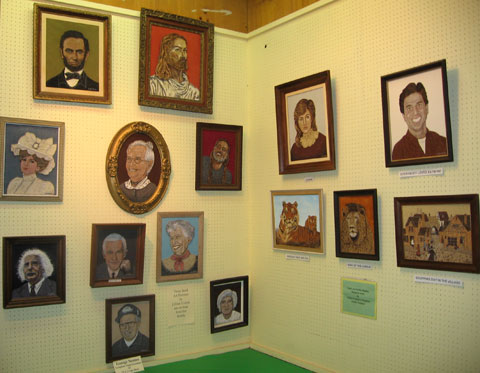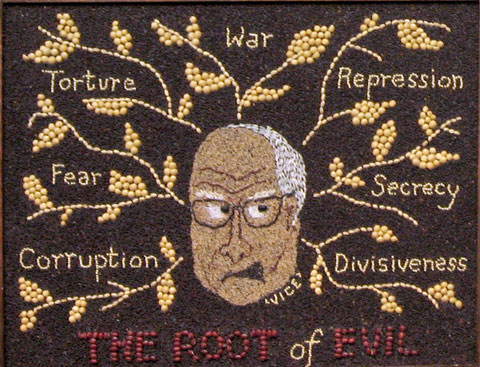Seeds of Change
Richard Barlow
Secrets of the City, Minneapolis
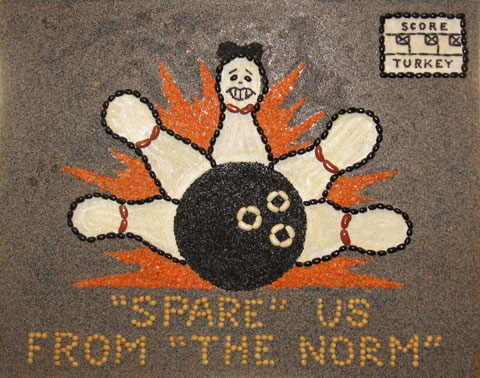
The first times I attended the Minnesota State Fair as a kid I found it disappointing. It seemed a little run-down, old-fashioned, and the rides were more rickety (and scary) than all the shiny new stuff at Valleyfair. Plus, I have never liked crowds. Somehow, though, that changed when I became a teenager. Maybe it was just more fun to go with friends than family, but I think the real key was a major discovery: ironic enjoyment. Suddenly things that had seemed old-fashioned became charming or hilarious, crowds that had been overwhelming became fascinating, and the bizarre and confounding elements were the new highlights. Demonstrations of spot-remover in the Grandstand! A stand devoted to milk! Butter carvings of beauty queens! I also discovered crop art.
The first time I saw the crop art display at the Fair must have been around 1985. I distinctly remember a couple of the highlights being portraits of Cyndi Lauper and Bill Cosby, but that both seemed a year or two out of date already. Of course, part of the appeal at the time was this ironic enjoyment. What could be goofier or more strange than portraits of celebrities made out of seeds? However, while ironic enjoyment may have opened the door to me looking at this work, my appreciation of these works quickly turned genuine. Creating a realistic portrait by affixing different colored seeds to a panel may be odd, but it certainly takes skill and patience. It was also clearly one of the highlights of the fair for me, as I remember telling incredulous friends about it years later while in college on the East coast.
Over the years I have seen many more of these celebrity portraits, and come to realize that the majority of the amazing portraits were by Lillian Colton, the “Seed Queen,” a legendary crop artist who passed away last year. She had been entering the crop art competition since 1966, won the best of show nine times, and was honored this year with a small retrospective display. I have to admit to only being a casual spectator of the displays, and had never quite put together that there were celebrities in the field, or that many of the same artists entered year after year. I hate to say it, but I am sure that was some kind of creeping “fine art” elitism on my part, and now I wish I had paid better attention. Seeing the Colton retrospective, and looking her up since on line, I realize that many of my favorite pieces have always been by one person.
Of course, many other people enter the competition each year, and not all artists create celebrity portraits. Last year I noticed a distinct trend in the crop art entrants: political crop art. This was pretty exciting. There were at least two pro-Al Franken pieces, an elaborate Looney Tunes reference (with Yosemite Sam shooting six-guns and crowing about “Mission Accomplished,”) and my favorite, by Teresa Anderson – a somewhat naïve and stylized image of Dick Cheney, with branches growing from his head marked “Corruption,” “Fear,” Torture,” “War,” “Repression,” “Secrecy,” and “Divisiveness.” Oh, and of course, the title written in large all-caps letters below “THE ROOT of EVIL.” Somehow you couldn’t help but come away from the exhibit feeling that middle America was pissed, and it was heartening to think that “regular,” crop-art making Minnesotans were giving voice to their frustrations.
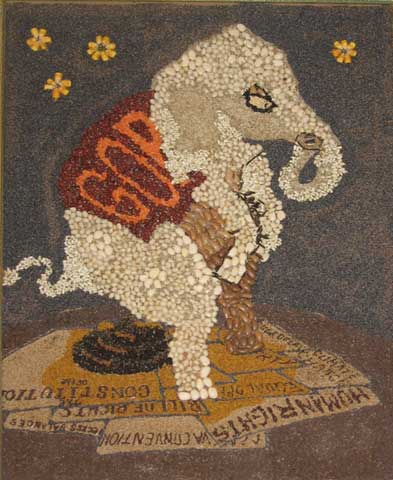
This year the trend continued, perhaps with even more urgency. I have to assume the RNC convention just a couple of miles from the exhibit hall may have something to do with this. Certainly it added to the impact of these crop art protests. Kim Cope’s anti-Norm Coleman piece was the most specific, depicting Norm’s head on a bowling pin in the midst of being explosively knocked down by a ball, with the punny inscription “’Spare’ us from ‘the Norm.’” (A nice added touch – the scoring box above displays a “turkey,” letting us know that this bowler has rolled three strikes in a row, presumably with the “Norm” pin going flying each time). The other pieces shared a couple of themes: elephants and their droppings. Paul Weig’s was perhaps the most overt, even labeling his elephant “GOP” as it squats to defecate on a pile of papers marked “Constitution,” “Bill of Rights,” “Climate Change,” “Human Rights,” etc. A second Kim Cope piece used a similar metaphor, depicting a shovel-wielding Barack Obama following a group of elephants as they head back to a big top tent, saying “Too bad we’re stuck cleaning up their messes!” as he scoops up piles labeled “gas prices,” “US debt,” “falling bridges,” “mortgage crisis,” “gitmo” and Iraq war.” Teresa Anderson’s entry made use of the same metaphor, depicting a line of elephants walking off a cliff, labeled “W,” “McSame,” “Norm” and “Tim,” with text above stating “Cleaning up after the elephants is the dirtiest job in the circus.” The most complex of the elephant referencing pieces was surely Laura Melnick’s elaborate Dr. Seuss riff, with Thidwick the Big-Hearted Moose supporting an elephant in his antlers, with a thought bubble declaiming, “what was I thinking?” Below the portrait was some Seuss-y text:Then he dozed off to sleep in his fine moose-hair nest.
"This elephant," said Thidwick,"is sort of a pest!
But I'm a good sport, so I'll just let him rest,
For a host, above all, must be nice to his guest"
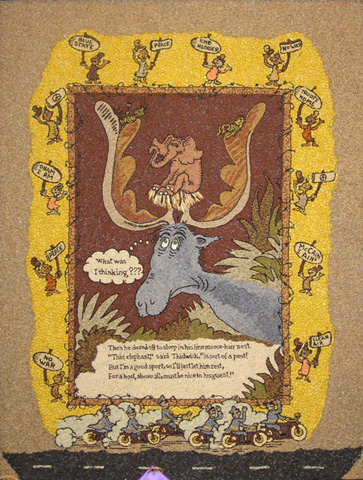
Whilst all around the border cartoon protesters hold signs saying “No War,” “Peace,” “Troops Home,” as well as the more Seussian “Obam I Am” and “McCain I Ain.”
Once again I came away immediately filled with the sense that regular midwestern folks had had enough of the current political situation, and were angry enough to say something about it in their own way. (A view that seemed reinforced by the relative lengths of the lines at the DFL and GOP booths at the fair, I might add). However, it dawned on me, once again, that I might have been making course generalizations and assumptions about who is making this crop art. I know nothing of these artists, and have no reason to believe they are rural midwestern voters, rather than urban hipsters, ironically enjoying an old-time craft. The fact is, though, that my initial assumption about the artists is part of the strength of this art as protest: true or not, this work reads as being the voice of common Midwestern folks, who are sick and tired of the current political situation. During every national election the parties and media suddenly discover their love for “real” Americans – the ones in the Midwestern “Heartland,” whose opinion is so crucial to the future of the nation. This Real American is a frustrating cipher. On the one hand, should such a person exist, the majority of Americans do not live lives like theirs, yet many hold this mythic figure in their hearts, as part of their self-definition. Since this figure is largely mythical, his traits and tendencies are pre-determined: hardworking, traditional, patriotic, anti-intellectual, pro-gun, and averse to subtlety and complexity. The portrait suggests that anyone with left of center views is not a real American, and the only populism that the Real American is truly allowed is anti-government, never anti-corporate. No one polls Real Americans to adjust the portrait, because anyone not fitting the description would by definition not be “real.” This, I think, is part of what gives these political crop art pieces their extra power. They read as though this mythic figure has had a change of mind, in a way that they wouldn’t if they were paintings, photos, collages or video-installations. Perhaps changing the attributes of the mythical Middle American is the key to a real change in political discourse.
